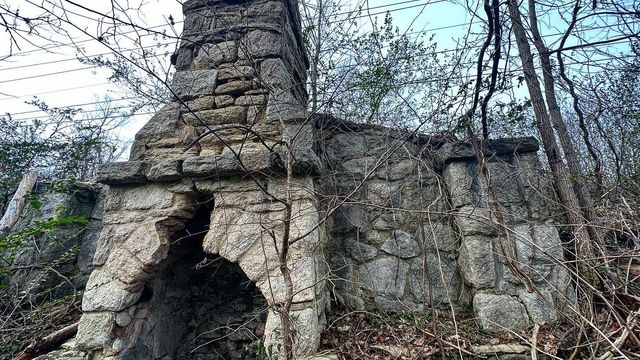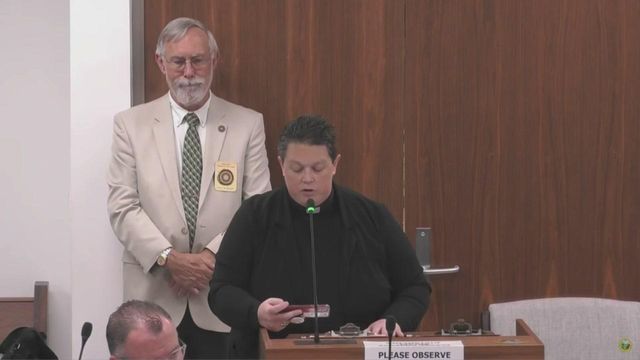Solved: Mysterious ruin along Raleigh highway dates back to Great Depression
If you’ve ever driven across the Neuse River on U.S. Highway 64, you may have wondered about a mysterious stone ruin crumbling along the side of the road.
The historic relic has been the center of debate for those who drive past: Why is an old stone chimney standing alongside a major local highway?
Some believe it's an old fireplace from an antique homestead. Others think it’s all that remains of an old riverside restaurant from the 1960s.
Historian Oakley Baldwin knows the real origin of that unusual structure. Decades ago he drove past it for the first time, and, like many others, he began to wonder what it used to be.

"I would drive by it every day, sometimes several times a day," he said. "And it was something that would catch my eye."
Barely hidden in the trees, the ruin consists of two stone pillars, a large oven and towering fireplace, a stone wall stretching out to either side and a stone slab serving as a table or counter top. Long ago, it had a roof overhead to provide shelter, but that has since collapsed. Recently, a fallen tree knocked over one of the pillars, and the entire place is overgrown with plants and weeds.
Despite being partially obscured by overgrowth, it's pretty easy to spot when cruising down US-64 into Knightdale.
"It did stick out like a sore thumb," said Baldwin, who first discovered the spot during his patrols as a Wake County deputy.

Built during the Great Depression as a way to feed highway workers
Most people don't recall a time before US-64 existed. But back during the Great Depression, hundreds of workers were employed as part of the Civilian Conservation Corps to build the first two lanes of highway.
"This site is where cooks would prepare meals for the 200-300 men working on US-64," said Baldwin.
He says workers made only a dollar a day, and they sent much of it home to their families.
"It was the Great Depression," he said. "Most of these men were struggling. President Roosevelt created the New Deal, and building this highway was part of that. It was a way to create jobs."
Cooks would work all day in the outdoor stone kitchen, cooking and delivering food up and down the line for miles.
Even today, a stone slab beside the fireplace reveals where cooks may have carved up entire pigs or prepped meals alongside the fire.
Built in the 1930s, it was used up until 1942 when the CCC disbanded. For years after, it would have been abandoned and unused.

The antique ruin becomes part of a new restaurant
Some locals swear the chimney and stove are remnants of an old restaurant they distinctly remember being along US-64 by the Neuse River. As it turns out, they're not entirely wrong, according to Baldwin.
"King's Riverside Restaurant sat right across the two-lane highway, and a lot of travelers and people hanging out on the river would eat there," said Baldwin.
This ruin wasn't part of the restaurant itself; however, the employees used the stove to cook for their customers.
"Many more mouths were fed from this stove years later," said Baldwin. "The only unsafe thing was that the employees had to leave the restaurant and cross Highway 64, two lanes, to cook the meals and then carry the meals back across. They probably did that several times a day."
The restaurant became a classic piece of small-town nostalgia for the families traveling along 64.
Unfortunately, the road that brought workers and customers would eventually be the reason the restaurant vanished. Today, the highway has expanded to four lanes. The footprint for King's Riverside Restaurant would now be around the median between the lanes.
CCC Camp sites: Other ruins hidden in plain sight
Other remains of CCC camp sites are hidden all across the United States. Photos and videos online show historic images of these sites, and some reveal similarly crumbling stone chimneys in other areas of North Carolina.
Many of these CCC camp site ruins can be found in national parks, in wooded areas and off hiking trails. Umstead Park was once the site of a CCC camp, meaning some stone ruins found in the woods off modern day hiking trails could belong to the camp –– or earlier farmers who inhabited the land as early as the 1800s.
In North Carolina, there were a total of 131 CCC camps running at one time. Some locals recall seeing similar chimneys crumbling along other stretches of US-64. Baldwin, who has not seen any himself, says it wouldn't surprise him if other chimneys or camp ruins could be found along the highway; however.
"CCC workers built along a stretch of many miles, it would make sense to have other cooking stations to help deliver food along the line," he said.

New development threatens this piece of Great Depression history
Even after the restaurant closed, Baldwin says people used the 1930s stove to cook, at least through the 1980s or 90s.
Fascinated with the ruin, Baldwin would check on it during his patrols.
"I'd find fresh charcoal in the stove," he said. "Somebody was still using it."
Families would stop along US-64 and have picnics, snapping memorable photos in front of the historic remnant.
Now, the antique site that has survived since the 1930s sits crumbling – trapped between the road and the new development being built behind it. A fallen tree has recently destroyed part of a pillar, and the rooftop is long gone. Baldwin fears this piece of Great Depression and NC history will be destroyed by construction – or by nature.

Chimney: 'To be removed'
So who owns this piece of history from the Great Depression in North Carolina?
According to records from Wake County Real Estate Data, the current owners of the property are Rogers Lane Partners LLC.
The tract of land is set to be used for a development called Edgewater Commons, which is currently being built behind the stone chimney.
WRAL found a Preliminary Subdivision Plan filed by developers with the City of Raleigh. There is only one mention of the chimney: A note on the map reads "old chimney (to be removed)."

WRAL has reached out to an employee of Rogers Lane Partners LLC to find out more about the possible removal of the ruins. We have not heard back yet.
Baldwin is hoping to see the stone chimney and surrounding remnants preserved – or even moved somewhere else for safe keeping – to keep it from being lost forever. Since very few people are familiar with the history of the site, he's hoping sharing its story could help encourage preservation.
"We have to make room for progress, but also save our history," he said.
Podcast: What was it like exploring this abandoned ruin?
Exploring a crumbling ruin along a busy highway -- what did we see? What was it like? WRAL Hidden Historian Heather Leah and WRAL News+ anchor Grace Holland talk about their adventure delving into this history mystery.











